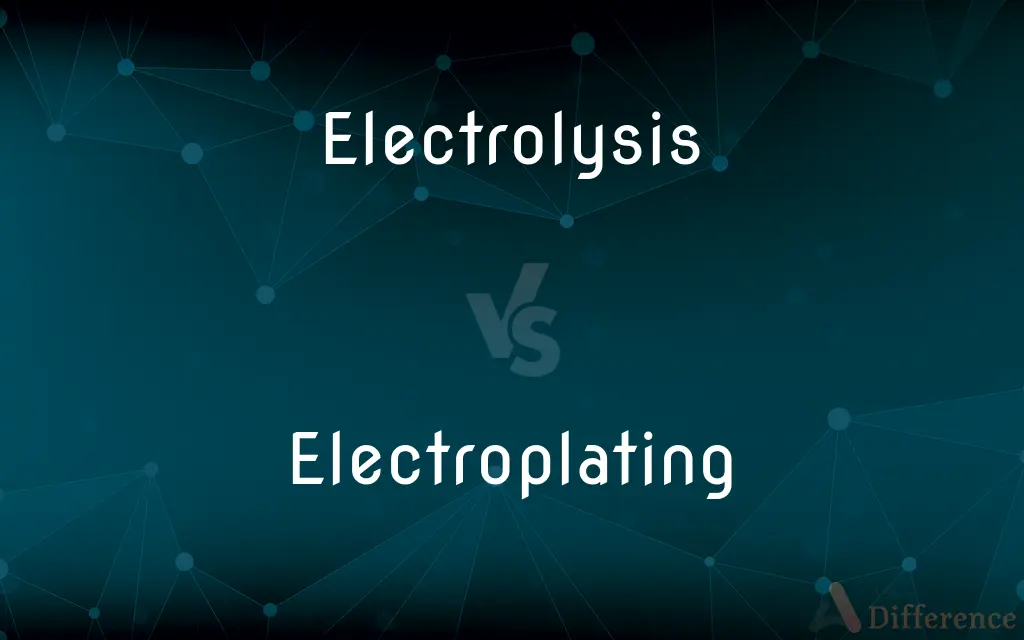Electrolysis vs. Electroplating — What's the Difference?
Edited by Tayyaba Rehman — By Maham Liaqat — Updated on March 21, 2024
Electrolysis involves separating elements through electric current, often for purification or decomposition, whereas electroplating deposits a metal layer on an object to enhance appearance or prevent corrosion.

Difference Between Electrolysis and Electroplating
Table of Contents
ADVERTISEMENT
Key Differences
Electrolysis is a chemical process that uses an electric current to induce a non-spontaneous chemical reaction, typically to decompose compounds. This is often used in the purification of metals, such as extracting aluminum from its ore. On the other hand, electroplating involves using electric current to coat an object with a thin layer of a different metal, aiming to improve the object’s appearance, prevent corrosion, or add other desired properties.
In electrolysis, an electrolyte compound undergoes chemical changes at the electrodes, resulting in the separation of its constituent elements. This process can also be used for applications like electrorefining and the production of chlorine gas and sodium hydroxide. Whereas, electroplating primarily focuses on depositing a metal layer onto the surface of another material, which can be for decorative purposes, to prevent rusting, or to increase surface hardness.
The equipment required for electrolysis can vary widely based on its application but fundamentally includes an electrolyte solution, two electrodes, and a direct current (DC) power supply. Electroplating similarly requires a power supply and electrodes (anode and cathode), with the workpiece to be plated serving as the cathode and the plating metal as the anode, submerged in an electrolyte solution specifically designed for plating.
Electrolysis reactions are generally not self-sustaining and require continuous input of electrical energy to proceed. These reactions are crucial in fields such as analytical chemistry and manufacturing. Electroplating, while also energy-intensive, is more commonly applied in manufacturing processes for consumer goods, electronics, and automotive parts to enhance product life and aesthetic appeal.
Despite their differences, both processes are integral to modern industrial and manufacturing sectors, utilizing the principles of electrochemistry. Electrolysis plays a key role in the extraction and refinement of metals and the production of chemicals, while electroplating is vital for material protection and enhancement.
ADVERTISEMENT
Comparison Chart
Purpose
Decomposition or purification of compounds.
Deposition of a metal layer on an object.
Main Application
Metal extraction, water splitting.
Aesthetic enhancement, corrosion protection.
Process
Non-spontaneous, requires electrical energy.
Requires electrical energy for deposition.
Electrode Material
Depends on the process.
Anode is usually the plating metal.
Industrial Application
Chemical production, metal purification.
Manufacturing of electronics, automotive parts.
Compare with Definitions
Electrolysis
Involves an electrolyte, anode, and cathode.
In electrolysis, ions move towards electrodes to create elements.
Electroplating
Utilizes an electrolytic cell for metal deposition.
Electroplating requires a cathode, anode, and electrolyte.
Electrolysis
Consumes electrical energy to drive chemical reactions.
Electrolysis of sodium chloride solution produces chlorine gas.
Electroplating
Can modify electrical conductivity and reflectivity.
Gold plating is used on electronics for better conductivity.
Electrolysis
A process to decompose chemical compounds using electricity.
Electrolysis of water produces hydrogen and oxygen gases.
Electroplating
A method to coat objects with a metal layer.
Silver electroplating is used for jewelry and cutlery.
Electrolysis
Has various applications in industry and energy.
Electrolysis is used in the production of sodium and chlorine.
Electroplating
Enhances appearance and corrosion resistance.
Chrome plating is popular for automotive parts.
Electrolysis
Used for the extraction and purification of metals.
Electrolysis is key in extracting aluminum from bauxite.
Electroplating
Applied in various industries for product improvement.
Electroplating is crucial in manufacturing durable consumer goods.
Electrolysis
In chemistry and manufacturing, electrolysis is a technique that uses direct electric current (DC) to drive an otherwise non-spontaneous chemical reaction. Electrolysis is commercially important as a stage in the separation of elements from naturally occurring sources such as ores using an electrolytic cell.
Electroplating
Electroplating is a general name for processes that create a metal coating on a solid substrate through the reduction of cations of that metal by means of a direct electric current. The part to be coated acts as the cathode (negative electrode) of an electrolytic cell; the electrolyte is a solution of a salt of the metal to be coated; and the anode (positive electrode) is usually either a block of that metal, or of some inert conductive material.
Electrolysis
Chemical change, especially decomposition, produced in an electrolyte by an electric current.
Electroplating
To coat or cover with a thin layer of metal by electrodeposition.
Electrolysis
Destruction of living tissue, especially of hair roots, by means of an electric current applied with a needle-shaped electrode.
Electroplating
Present participle of electroplate
Electrolysis
(chemistry) the chemical change produced by passing an electric current through a conducting solution or a molten salt.
Electroplating
A process of coating the surfaces of a metal object with a layer of a different metal through electrochemical means, usually to exploit different properties of the materials.
Electrolysis
The destruction of hair roots by means of an electric current.
Electroplating
The art or process of depositing a coating (commonly) of silver, gold, or nickel on an inferior metal, by means of an electric current. The metal to be deposited on an article is usually used as the anode and the article to be plated as the cathode, in an electrolyte solution in which the plating metal is the cation. The process is conducted in a tank called an electroplating bath, which holds the electrolyte solution.
Electrolysis
The act or process of chemical decomposition, by the action of electricity; as, the electrolysis of silver or nickel for plating; the electrolysis of water.
Electrolysis
Lysis of a bond produced by the passage of an electric current
Electrolysis
Removing superfluous or unwanted hair by passing an electric current through the hair root
Common Curiosities
What is electrolysis used for?
Electrolysis is used for metal purification, chemical production, and water splitting.
What metals are commonly used in electroplating?
Gold, silver, copper, nickel, and chromium are commonly used in electroplating.
Can electroplating prevent rust?
Yes, electroplating can prevent rust by coating the object with a corrosion-resistant metal layer.
How does electroplating work?
Electroplating works by using an electric current to deposit a metal layer onto an object, improving its properties.
Can electrolysis separate any compound?
Electrolysis can separate compounds that are ionic and dissolve in water or other solvents to conduct electricity.
Can electrolysis and electroplating be used together?
Yes, they can be used together in processes like refining metals before plating them.
Is electrolysis energy-intensive?
Yes, electrolysis requires a significant amount of electrical energy to drive non-spontaneous reactions.
What is the key difference between electrolysis and electroplating?
The key difference is their purpose: electrolysis is for decomposition or purification, while electroplating is for coating objects with metal.
What materials can be electroplated?
Metals, and sometimes plastics with a conductive coating, can be electroplated.
Does electrolysis have environmental applications?
Yes, electrolysis is used in environmental applications like water treatment and renewable energy storage.
Can electrolysis produce hydrogen fuel?
Yes, electrolysis of water is a clean method to produce hydrogen fuel.
What is the anode in electrolysis?
The anode is the electrode where oxidation occurs, often contributing electrons in the process.
What is the cathode in electroplating?
In electroplating, the cathode is the object being plated, where reduction and metal deposition occur.
What industries benefit most from electroplating?
The automotive, electronics, and jewelry industries benefit significantly from electroplating.
How does electroplating affect the environment?
Electroplating can have environmental impacts due to the use of toxic chemicals and metals, necessitating careful waste management.
Share Your Discovery

Previous Comparison
Bibliography vs. Biography
Next Comparison
Quiet vs. ShyAuthor Spotlight
Written by
Maham LiaqatEdited by
Tayyaba RehmanTayyaba Rehman is a distinguished writer, currently serving as a primary contributor to askdifference.com. As a researcher in semantics and etymology, Tayyaba's passion for the complexity of languages and their distinctions has found a perfect home on the platform. Tayyaba delves into the intricacies of language, distinguishing between commonly confused words and phrases, thereby providing clarity for readers worldwide.
















































